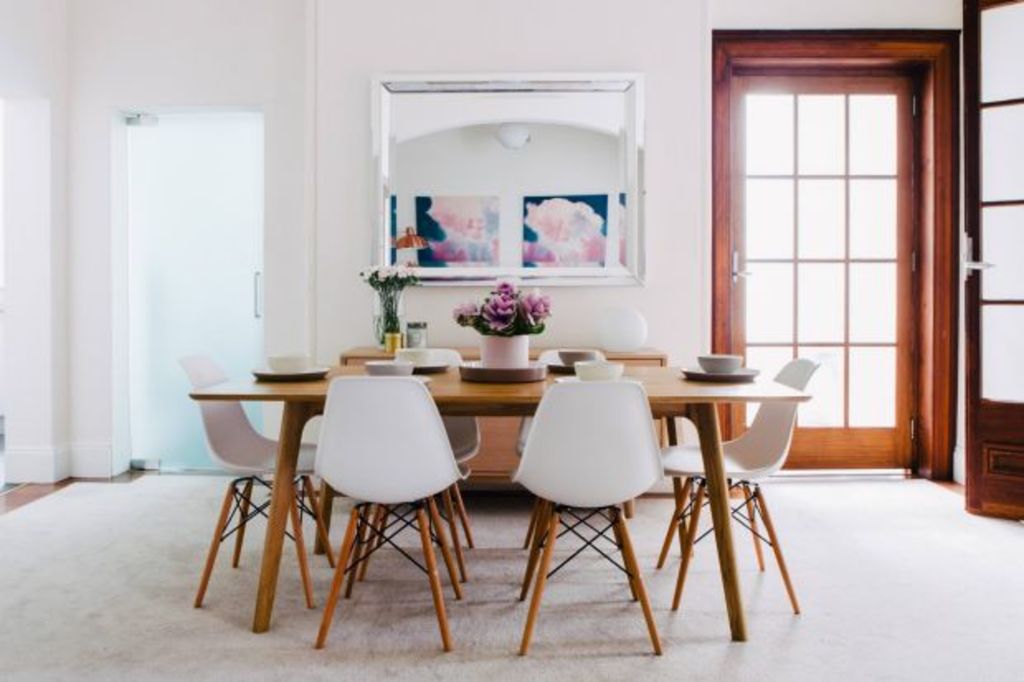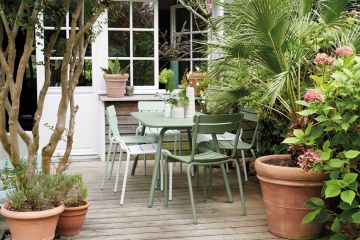Australian design trends inherited from other countries

Open-plan living
Open-plan living is strongly linked to mid-century modern design that gained mainstream popularity in the US after World War II.
While the Mad Men-esque style of mid-century homes is not to every buyer’s taste, the informal floor plan this era popularised remains extremely common. Most houses built in Australia today feature an open-plan living domain with adjacent living, dining and kitchen areas.
“Australians are definitely house proud and generally love to entertain, so open-plan living really lends itself to this,” says Satya Aishwarya, lead designer at Decorum Interiors.
“Kitchens are now quite the showpiece of a home, and the open-plan layout really allows them to shine.”
It’s a similar story in renovated properties, with many home owners now choosing to open up the defined spaces of original Edwardian, Victorian and inter-war homes.
“My house is an art deco 1930s home and I removed the wall between the kitchen and the dining room … It has made the dining area less formal and as a result we use it every day,” says Bethany James-Best from James Said.
The enduring interest in open-plan living today can be largely attributed to Australians’ penchant for entertaining.
“Australians have a strong social culture and love to entertain in their homes, so having a flow throughout the main hubs – kitchen, living, dining – ensures that even if you’re in the kitchen preparing a meal or in the living room chatting to guests, everyone can be in on the action,” says Bianca Hung, senior associate at Hayball.
Many open-plan spaces also offer openings to the outdoors, another key part of the Australian lifestyle.
“I love to feel connected to the outdoors just like most Aussies and open-plan living gives you the best opportunity for that,” says Carpet Court ambassador, author and interior designer Darren Palmer.

The enduring interest in open-plan living today can be largely attributed to Australians’ penchant for entertaining. Photo: Shannon McGrath
Scandinavian design
Scandinavian design originated in the Nordic countries (Sweden, Finland, Norway, Denmark and Iceland) in the 1950s.
Pioneered by designers such as Hans Wegner, Alvar Aalto and Arne Jacobsen, this style is characterised by its simplicity, functionality and use of soft, neutral tones.
“The clean lines and minimal style are an idealistic way to live, and while most people may not be able to sustain that, having the look with pared back simple lines and soft colours is calming,” says Kylie Harding from Styled to Sell.
In Australia, Scandinavian design has emerged as dominant style more recently, and can be credited in part to the growing presence of IKEA since 1975.
“Scandinavian countries and all they encompass are trendy at the moment. From their royalty to “hygge” [the Danish practice of snuggling up and appreciate life’s little luxuries], Australians have embraced that way of life,” Harding says.
“The Scandinavian style is light fresh and neutral, so it will naturally appeal to a broad market. This palette works well with the Australian environment because it’s not dissimilar to a coastal style,” says Justine Stedman, director and principal Stylist at Vault Interiors.
Scandinavian-inspired homewares currently saturate the mainstream design market, but the longevity of this style divides experts.
“In terms of style, Scandinavian design is definitely a trend at the moment, but some of the basic elements of the style, like light walls, blonde floors and timbers will have substantial longevity,” Hung says.
“The consumer level product that we have an apparent glut of in the market will wane as the next trend comes to the forefront. However, there will always be a place for authentic Scandinavian design, whether it be contemporary style or in the form of design classics,” Palmer says.

Glebe Residence by Woods and Warner. Photo: AnnekeÌ Hill
French doors
The origins of French doors stem back hundreds of years to the 16th century when France was at war with Italy. It was during this time that architectural influences from the Renaissance period, with a focus on proportion and symmetry, became evident in France.
As a pre-electricity invention, French doors were highly practical as they allowed added light into rooms.
French doors have been a part of Australia’s history for more than 200 years. They are a functional and decorative item that adds charm, history and light to any space.
“Australians love to bring the outdoors into the home and French doors do this in the most elegant way,” James-Best says.
“Not only do they bring the view in, they allow sunlight to enter the home. They also allow light to travel between rooms when used internally.”
French doors allow a more seamless connection between indoors and out, which is appreciated by most Australians.
“Again it goes back to our love for open-plan living and bringing the outdoors in. An effortless transition from indoors to outdoors is an important design element and French doors are a stylish way to achieve this,” says Christie Turvey, of Neue Blvd.
French doors may be common, but the wide range of styles available make this a design feature that’s here to stay.
“They are timeless and beautiful, the Audrey Hepburn of doors,” Palmer says.
For a look that balances tradition with contemporary style, try a French door framed with black steel.
“The fine black frame maximises the view to the outdoors whilst looking elegant,” says Lauren Li from Sisällä Interior Design.

Styling by Emma Blomfield, co-founder of The Decorating School.
Minimalism
Japanese-inspired minimalist interiors are on the rise in Australia, with many high-end luxury homes now adopting this style.
In Japanese minimalism, interiors are kept simple with a mostly dark palette of black, grey and white. Little decoration is incorporated and a use of natural materials such as wood and bamboo keeps homes grounded in nature.
“Japanese minimalism is quite naked and bare, clean-cut with structured lines. I think this has become popular for those who are seeking to de-clutter, and those who enjoy living in open, clean and monotone spaces,” says Therese Moussa, creative developer and stylist at The Grounds of Alexandria.
Experts associate Australia’s current fondness for Japanese minimalism with the growing desire to disconnect, de-clutter and create a greater work-life balance.
“We live in such a busy time where we are always ‘switched on’. The ancient art of Japanese minimalism appeals to us as we strive to de-clutter our minds,” says Tennille Burnup, from Tennille Joy Interiors.
“Marie Kondo’s The Life-Changing Magic of Tidying Up has taken the world by storm and it started at home. I challenge you to read it and not start rifling through cupboards that haven’t seen the light of day for years,” says Emma Blomfield, interior stylist and co-founder of The Decorating School.
Japanese minimalism is also highly conducive to Australia’s growing apartment culture.
“We need to change the way we think about furnishing apartments. There is a different approach needed than furnishing a large house,” Li says.
“Japanese furniture is slightly scaled down to accommodate for small spaces, and should be multifunctional.”
Of all the international styles and trends, experts say Japanese minimalism can be one of the hardest to adapt into Australian homes.
“It’s quite a big lifestyle switch for most Australian homes, though, as we have some of the biggest homes in the world, whereas the Japanese have some of the smallest,” Aishwarya says.
“Minimalism is the most complex to execute and if designed well can be breathtaking. If you execute well, each piece stands alone in its glory and allows architecture and external views to take precedence,” says Sonia Warner and Jacinta Woods from Woods and Warner.

We recommend
We thought you might like
States
Capital Cities
Capital Cities - Rentals
Popular Areas
Allhomes
More







